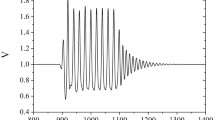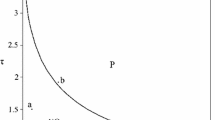Abstract
We present a systematic analysis of the dynamical behavior introduced by fault zone heterogeneities, using a simple mass-spring model with velocity-weakening friction. The model consists of two sliding blocks coupled to each other and to a constant velocity driver by clastic springs. The state of this system can be characterized by the positions of the two blocks relative to the driver. Symmetry stabilizes the system and generates only cyclic behavior. For an asymmetric system where the frictional forces for the two blocks are not equal, the solutions exhibit chaotic behavior. The transition from stable cyclic behavior to chaos is characterized by the period-doubling route to chaos. Lyapunov exponents are computed to quantify the deterministic chaos and to locate the onset of the chaotic evolution in parameter space. In many examples of deterministic chaos, chaotic behavior of a low-order system implies chaos in similar higher order systems. Thus, our results provide substantial evidence that crustal deformation is an example of deterministic chaos.
Similar content being viewed by others
References
Aki, K.,A probabilistic synthesis of precursory phenomena. InEarthquake Prediction (eds. Simpson, D. W., and Richards, P. G.) (American Geophysical Union, Washington, D. C. 1981) pp. 566–574.
Burridge, R., andKnopoff, L. (1967),Model and Theoretical Seismicity, Bull. Seismol. Soc. Am.57, 341–371.
Byerlee, J. (1970),The Mechanics of Stick-slip, Tectonophys.9, 475–486.
Byerlee, J. (1978),Friction of Rocks, Pure and Appl. Geophys.116, 616–626.
Cao, T., andAki, K. (1984),Seismicity Simulation with a Mass-spring Model and a Displacement Hardening-softening Friction Law, Pure and Appl. Geophys.122, 10–23.
Cao, T., andAki, K. (1986),Seismicity Simulation with a Rate and State Dependent Friction Law, Pure and Appl. Geophys.124, 487–513.
Carlson, J. M., andLanger, J. S. (1989),Properties of Earthquakes Generated by Fault Dynamics, Phys. Rev. Lett.62, 2632–2635.
Cohen, S. (1977),Computer Simulation of Earthquakes, J. Geophys. Res.82, 3781–3796.
Dieterich, J. H. (1972),Time Dependent Friction as a Possible Mechanism for Aftershocks, J. Geophys. Res.77, 3771–3781.
Dieterich, J. H.,Experimental and model study of fault constitutive properties. InSolid Earth Geophysics and Geotechnology (ed. Nemet-Nasser) (AMSE, NY 1980) pp. 21–30.
Dieterich, J. H.,Constitutive properties of faults with simulated gouge. InMechanical Behavior of Crystal Rocks (eds. Carter, N. et al.) (Geophys. Monogr. 24, AGU, Washington D.C. 1981), pp. 103–120.
Gu, J., et al. (1984),Slip Motion and Stability of a Single Degree of Freedom Elastic System with Rate and State Dependent Friction, J. Mech. Phys. Sol.32, 167–196.
Huang, J., andTurcotte, D. L. (1990),Are Earthquakes an Example of Deterministic Chaos? Geophys. Res. Lett.17, 223–226.
Lorenz, E. N. (1963),Deterministic Nonperiodic Flow, J. Atmos. Sci.20, 130–141.
May, R. M. (1976),Simple Mathematical Models with very Complicated Dynamics, Nature261, 459–467.
Nussbaum, J., andRuina, A. (1987),A Two Degree-of-freedom Earthquake Model with Static/Dynamic Friction, Pure and Appl. Geophys.125, 629–656.
Parez Pascual, R., andLomnitz-Adler, J. (1982),Coupled Relaxation Oscillators and Circle Maps, PhysicaD30 61–82.
Rice, J. R., andTse, S. T. (1986),Dynamic Motion of a Single Degree of Freedom System Following a Rate and State Dependent Friction Law, J. Geophys. Res.91, 512–530.
Rikitake, T. (1958),Oscilation of a System of Disc Dynamos, Proc. Cambridge Phil. Soc.54, 89–105.
Robbins, K. A. (1977),A New Approach to Subcritical Instability and Turbulent Transitions in a Simple Dynamo, Math. Proc. Camb. Phil. Soc.82, 309–325.
Sparrow, C.,The Lorenz Equations: Bifurcations, Chaos and Strange Attractors (Springer-Verlag, New York 1982) 269 pp.
Ruina, A. (1983),Slip Instability and State Variable Friction Laws, J. Geophys. Res.88, 10,359–10,370.
Rundle, J. B., andJackson, D. D. (1977),Numerical Simulation of Earthquake Sequences, Bull. Seismol. Soc. Am.67, 1363–1377.
Wolf, A., andSwift, J.,Progress in computing Lyapunov exponents from experimental data. InStatistical Physics and Chaos in Fusion Plasmas (eds. Horton, C. W. Jr., and Reichl, L. E.) (Wiley, New York 1984) pp. 111–125.
Author information
Authors and Affiliations
Rights and permissions
About this article
Cite this article
Huang, J., Turcotte, D.L. Chaotic seismic faulting with a mass-spring model and velocity-weakening friction. PAGEOPH 138, 569–589 (1992). https://doi.org/10.1007/BF00876339
Accepted:
Issue Date:
DOI: https://doi.org/10.1007/BF00876339




